|
Interviews by Richard Thomas
Drums from the Big Room was recorded over a three-day period at the world famous O’Henry Sound Studios in Burbank, California. We sat down with Steve Ferrone, Greg Ladanyi, and Sony Sound Development Manager Mike Scheibinger to get a first-hand account of what went into capturing this incredible collection.
Obviously the music industry isn’t as strong an entity as it was just ten years ago. Record sales are slumping and illegal file-sharing has made a signifcant impact on the way business is done. As a big name producer, has all this caused you to shift your focus?
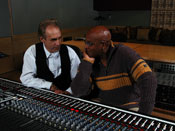 Greg Ladanyi: I grew up working at the Sound Factory with David Hassinger, Doug Ray, Peter Asher, Gene Paige, Frankie Valli and the Four Seasons and Bob Gottio — studios were where you went to make records, and it was like that from the fifties on. In the nineties, the music was shifting big time into rap music, so a lot of what I did as far as rock, folk or pop…it was difficult. I think the record business was focusing more, as they have and as they always will, on what's selling, and rap music was selling. So while you had certain groups that would maintain a steady flow of rock and pop, rap music was predominately the thing they wanted to sign and do. In the mid-nineties, the Internet and Napster made the music more accessible. I think the record companies had opportunities to deal with that in a certain way and chose not to, and it really blew up. All of a sudden, people could get music a different way, and unfortunately, for free. Greg Ladanyi: I grew up working at the Sound Factory with David Hassinger, Doug Ray, Peter Asher, Gene Paige, Frankie Valli and the Four Seasons and Bob Gottio — studios were where you went to make records, and it was like that from the fifties on. In the nineties, the music was shifting big time into rap music, so a lot of what I did as far as rock, folk or pop…it was difficult. I think the record business was focusing more, as they have and as they always will, on what's selling, and rap music was selling. So while you had certain groups that would maintain a steady flow of rock and pop, rap music was predominately the thing they wanted to sign and do. In the mid-nineties, the Internet and Napster made the music more accessible. I think the record companies had opportunities to deal with that in a certain way and chose not to, and it really blew up. All of a sudden, people could get music a different way, and unfortunately, for free.
So what do you think that did to the grand studio experience?
Greg Ladanyi: Technology was becoming more and more driven by digital operations, the home studio became cheaper and cheaper to have, and the quality was rising. You could work in a home studio, do a lot of things with machines, and maintain a certain quality that you were not able to have in the seventies and eighties. That hurt the studio business, and I think as the Internet developed this power to move music, it created a real alienation between people paying for music and record companies with over-budgeted payrolls. As people began making records in their home studios, players weren't really being used. Records were being made without people. There were sequencers and loops. But it's the way it is. I don't really look at any of that as a bad thing, because for me, it's helped me make records better. But my career was basically surrounded by people that, while they had to be careful with budgets — Jackson Browne, Don Henley, Toto, Fleetwood Mac — there were budgets. We were able to spend quality time in the studio. Sometimes we spent too much money and the records never recouped, but for the most part the records were successful. But either you become part of the movement, or the movement keeps going and you just wave at it. So I built a digital 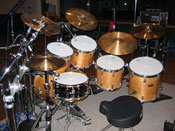 studio that I could work in, understand the technology better, and maintain a place where I could work at the same level of competence and integrity that I was used to working at in the studios. I don't compromise a record's time in the studio because there's no budget. studio that I could work in, understand the technology better, and maintain a place where I could work at the same level of competence and integrity that I was used to working at in the studios. I don't compromise a record's time in the studio because there's no budget.
Steve Ferrone: Fads come and go. Fads have come and gone in this business for years and years since the beginning of it; like all of a sudden when guys had to stop playing the violin and start playing the saxophone. But there will always be musicians around, because that's something you can't replace. Sooner or later, whatever you do to be cheap is going to come back to the fact that somebody is going to have to play it, you know? People are going to start saying, "Well that doesn't sound like the old stuff does," and the old stuff is full of mistakes and life.
How long have you known Greg?
Steve Ferrone: For ages. Seen him around studios over the years. He used a lot of my friends for musicians out in L.A. mainly…guys out here that I knew.
Did you envision bringing anything into these sessions from a production standpoint?
Steve Ferrone: For me, when I sit down and start playing, it can take me to a lot of different places. Greg had specific ideas of what he wanted. It was like working for a producer to do a record. "Okay, I've got this song and it goes like this. Here's got the tempo."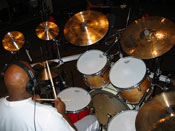 In all the years that I've been working in studios — and I own a studio — I know how to turn it on. That's it. I don't know anything about recording. I know about sound. I know about selecting drums to use to make a thing sound good. But when people say to me, "What kind of microphones do you like on your drums?" I say, "Ones that sound good." My job is to find out what the direction is and then add me to the mix. I can walk into a studio and sit down, take look at my setup and know if something's missing, but as far as the technical aspect of recording, I've got my board over there and I know how to turn it on. There are people out there who are talented at doing that, and I leave that to them…if they leave the drumming to me. In all the years that I've been working in studios — and I own a studio — I know how to turn it on. That's it. I don't know anything about recording. I know about sound. I know about selecting drums to use to make a thing sound good. But when people say to me, "What kind of microphones do you like on your drums?" I say, "Ones that sound good." My job is to find out what the direction is and then add me to the mix. I can walk into a studio and sit down, take look at my setup and know if something's missing, but as far as the technical aspect of recording, I've got my board over there and I know how to turn it on. There are people out there who are talented at doing that, and I leave that to them…if they leave the drumming to me.
Greg, what do you feel is the biggest knowledge gap between producers at your level and people who only have Digital Audio Workstation experience?
Greg Ladanyi: Guys that I've worked with in the studio — guys that really blow me away with the computer — are a tremendous asset to me, but what they don't have is the organic balance of how that happens. There is a sonic difference that's there with live music and someone who knows how to use microphones [and] those things are now showing up in the computer with samples. If you take one of those guys that can run a computer and put him in the studio and say, "Go mic the drums," he's lost. Doesn't mean he doesn't want to learn, but because he never has learned, there's a hole there in the ability to understand what a performance means. Dynamics is really one of the biggest things about music, and it's an art that needs to be protected. Compression, as it's used today, is a really bad thing for musicians' dynamics. Every artist plays music the way they feel it in their bodies. They'll hit the guitar strings harder or the keys harder based on what's going through their body, and that's part of a sound. That's stuff you want to know about when you buy a U2 or a David Bowie record. You want to know how these people feel about their performances, and if that's taken away, you can't really dive into that area of how they're playing their songs. Sequencers don't really deal with that phenomenon. It's like a flat line. The parts are there and you can make everything happen, but there's no depth in the dynamics.
You recorded the sessions at O'Henry Sound Studios in Burbank, a place with a lot of history. What part did the studio itself and the room play in the recording of these sessions?
Mike Scheibinger: The space was critical. I've never recorded in a space that sounds this good. Just an immense sound with no flakiness. All the control we needed we achieved with nothing but rugs on the floor. Steve can be a seriously heavy hitter, and this room just responded magically to that. But all this might not mean very much if we didn't actually capture the sound of the entire space. On this collection you have three very different axes of room control, so you'll be able to do whatever you feel like doing. Then there's the desk and all the outboard stuff we used — nothing but the finest, most vintage, and most well-maintained stuff you can get. At the end of the day, this collection is totally uncompromised. Every piece is in place.
What was your primary goal in creating this drum library? How did the three of you set out to really get the goods?
Greg Ladanyi: What's important for me is that you're contributing to the trend, not just using it. I use drum libraries, I use loops, and there are things I wanted to do to make this better than everything else. We played songs from the beginning to the end in the studio, and the loops are put together with seven tracks: bass drum, snare, toms, overheads, and that compressed room mike. You bring seven tracks into your session and you can balance them any way you want; make them dry and direct or ambient and room mikey. And we did individual hits as well, so you can build your own patterns.
How were the mics set up to achieve this?
Mike Scheibinger: The drums were miked in the usual manner for recording rock drums, with a mic or two on each instrument. We paid a lot of attention to the ambient microphones, knowing that our users are going to be really into working with that amazing room in a bunch of different ways. You have three mixable choices with three entirely distinct pictures of the room, plus the individual drums themselves to work with.
Greg Ladanyi: I used three ribbon microphones close to the cymbals to get the attack from the stick. Most of the bottom is rolled out of those microphones from about 100 Hz down. All I want is the definition of the attack, and the reason I use 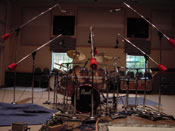 three is because the center area where the ride cymbal is can be not as present as the outside crash cymbals. Those microphones are usually about four to six inches away from the cymbals, depending on how hard the guy plays. The top microphones are the Telefunken 251s that have the great bottom end for the toms and the room, but they create the size and the air of the cymbals. Then I used the Sony C37 with compression, about eight to ten feet directly over the drummer's head. Amazing. There was a good, warm, crisp sound from the cymbals. Then I mixed the mikes together to create a sound for the song. If it's a rock tune or a really aggressive thing, that mono-compressed mic over the drummer's head can become a predominant part of the sound. The individual microphones are not overly EQed and never gated. I don't like using any gates on drums. I think it's very hard to set the threshold on a gate that's specific to the way a drummer plays. There are about 14 tracks of drums recorded, and with the different configuration of room and cymbal microphones, you can dictate the balance that's needed for the type of song you want. This collection is really versatile. three is because the center area where the ride cymbal is can be not as present as the outside crash cymbals. Those microphones are usually about four to six inches away from the cymbals, depending on how hard the guy plays. The top microphones are the Telefunken 251s that have the great bottom end for the toms and the room, but they create the size and the air of the cymbals. Then I used the Sony C37 with compression, about eight to ten feet directly over the drummer's head. Amazing. There was a good, warm, crisp sound from the cymbals. Then I mixed the mikes together to create a sound for the song. If it's a rock tune or a really aggressive thing, that mono-compressed mic over the drummer's head can become a predominant part of the sound. The individual microphones are not overly EQed and never gated. I don't like using any gates on drums. I think it's very hard to set the threshold on a gate that's specific to the way a drummer plays. There are about 14 tracks of drums recorded, and with the different configuration of room and cymbal microphones, you can dictate the balance that's needed for the type of song you want. This collection is really versatile.
Mike Scheibinger: Of course, the more mics you put on a kit, the more options you have for mixing, but you have to keep it real. We think that we did a good job of consolidating and submixing all the close mics so that you'll be able to have a huge variety of choices while still keeping your track count realistic.
Greg Ladanyi: While we want to contribute to the art of technology, we also want to contribute to the art of performing, and hopefully you'll have a young guy wanting to learn how to play drums by what he gets here. You'll have great sounding drums that were all recorded acoustically on a digital platform, and it's all organic; the real deal. It's not about playing four bars. It's about capturing real playing with the way the drums are really recorded with a real guy playing and feeling the rhythm. We were jamming for three or four minutes on a groove, and it captures that energy. So when you put it into your record, you've got the energy. I'm not approaching recording as if it were a digital drum loop. It's all about recording the drums organically and acoustically the same way I would for a record. The end user is going to decide whether he wants drums that are tight and clean or if he wants more ambient or more compressed. It's not going to be me. We're offering a number of ways to arrive at that.
You also used a number of Sony Oxford Plugins for the session. How did those work out?
Greg Ladanyi: That Sony stuff is unbelievable. The Oxford Compressor, the way they've organically tuned the plug-in to work with music, is very cool. You can hit 'em pretty hard and they don't crunch up on you. They also have EQ attached to the compressor, so you could EQ it pre or post. They really give you a lot of options, musically, in how you can use it. The five-band EQ is fantastic. Digital EQ is a really sensitive EQ, especially when you get into the mid-range and the high end, but Sony seems to have a really smooth top end. The midrange is punchy and aggressive but not brittle, and the bottom end is tight when you wind it up. With the TransMod, you can add a shimmer of high end to a mix, but it's not the same thing as adding three or four decibels at 7k with an equalizer. It uses the harmonics, and gives you a sheen on top of your mix that you can bury with the rise and release time. They're all really good, valuable sounding plugins for the DAW workstation.
What drums did you use for these sessions?
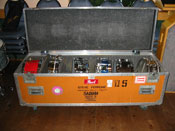 Steve Ferrone: I used two drum kits, three different bass drums, and maybe five different snare drums. As far as basic kits, I've got a 1960's Round Badge Gretsch Broadcaster. That's a beauty man. I'm a big Gretsch fan. It's just classic sounding stuff. Then I used my very first Pearl kit I got from them. That kit has to be 20 years old now. It's a Japanese maple shell kit. A lot of drum sets out there have good sound, but Gretsch and Pearl, for me, sound great. When I did the [Eric Clapton] Unplugged sessions, I had Pearl make me a drum kit. They made a 26-inch Z Series bass drum, which is really big, so we used that on a couple of the tracks. We used a Pearl free floating piccolo snare drum which, for me, is the most versatile snare drum. Then I used my Pearl signature snare on there, as well as a Kumu and an old Ludwig Black Beauty. My tech, Dave Green, was there and he's really good at tuning drums and keeping everything sounding even. People can mix and match as much as they want. Steve Ferrone: I used two drum kits, three different bass drums, and maybe five different snare drums. As far as basic kits, I've got a 1960's Round Badge Gretsch Broadcaster. That's a beauty man. I'm a big Gretsch fan. It's just classic sounding stuff. Then I used my very first Pearl kit I got from them. That kit has to be 20 years old now. It's a Japanese maple shell kit. A lot of drum sets out there have good sound, but Gretsch and Pearl, for me, sound great. When I did the [Eric Clapton] Unplugged sessions, I had Pearl make me a drum kit. They made a 26-inch Z Series bass drum, which is really big, so we used that on a couple of the tracks. We used a Pearl free floating piccolo snare drum which, for me, is the most versatile snare drum. Then I used my Pearl signature snare on there, as well as a Kumu and an old Ludwig Black Beauty. My tech, Dave Green, was there and he's really good at tuning drums and keeping everything sounding even. People can mix and match as much as they want.
You also played one shots as well, right?
Steve Ferrone: Yeah, if they don't like the way I've played it but they like the sound, they can have that too.
What's been your history with loops in the recording process?
Steve Ferrone: There was a change that was going on when I was doing a lot of session work in New York around the early eighties…when I first started working with Scritti Politti. I'd go in there, but there was no song, just a click track. And then all of a sudden people started to ask you to play to these loops. I think the main problem that started to happen with the machine was the feel of it. It was a little too stiff, so they'd add a live hi-hat or crash cymbals just to make it feel right. In certain situations it was perfect, but if they were doing rock, it didn't have the feel they wanted. But this really constant thing would happen with the loop, and then everybody started to cut with them. "We've got to find a loop!" And either they'd lift something off somebody else's record, or they'd manufacture something and have me play to it. I didn't mind playing with a click, and I didn't mind playing with a loop, but I really didn't like playing to the drum machine. There was something about it that didn't gel right.
How would you pitch this collection to another drummer?
Steve Ferrone: I've played on a lot of hit records. I listen to these records and say, "Let me have a listen and try and figure out if it was a hit record before I played on it, or if I brought something to it that made it a hit." Music like Duran Duran's Ordinary World. They played me that demo and I said, "You don't need me on there, that's a hit already." But I did get to play on it, and they felt that I brought something to it. If you're using this stuff as a writing tool, it should have my feel. Which is not to say that my feel is right all the time, but I'd say if you look at my track record, it's been pretty close a lot more than it's been wrong. That's the object of doing this thing - to give people a tool to write with that's not a drum machine, something that has that feel and that sound. Some of the material that's lying around nowadays is kind of weak, you know? I think this stuff gives you more than just a basic tick tock drum beat. Just the feel and the sound of it are more inspiring for a musician to sit down and start writing with.
Were there any grooves or production tactics or "signature sounds" you tried to get from the sessions?
Mike Scheibinger: Greg insisted on a purist approach: capture the sounds of the drums, the sounds in the room, just capture that with no gimmicks. You could say that this is actually Greg's normal way of working. His records are mostly about people playing their instruments in a studio with no coloration — just capturing moments with the most faithful fidelity possible. Most of the signal processing was typical and very, very light, so the end user who wants to experiment with signal and effects processing will be able to do that with pristine materials right from the start. As far as grooves go, Steve can play anything. With most players, you just try to zero in on what they do the best, what they're known for. Ferrone isn't really a signature sound kind of player, although that could be argued I guess, especially by drummers! My point is, Steve can just play anything well, and he can do so fluidly and automatically without having to do too much thinking. All that stuff is just coded in his muscle memory over years and years of playing with literally hundreds of different artists. With that advantage, we were able to concentrate on what the end user might like to have, more than on just what the talent can play. So what happened was, we were able to bring out a set with a lot of different styles, from rock to funk to reggae to jazz - all the better!
Greg Ladanyi: Steve has played with Tom Petty and Average White Band, and his style is clean and very soulful. Lots of driving grooves. He's not a very flashy drummer with fills and everything, but sexy as a mother on grooves, and in a record you need that backbone. You really need that glue to be solid, and Steve does that. Internationally, Steve has played everything from R&B to rock…his way.
Greg Ladanyi is a first rate producer and Steve Ferrone is easily one of the finest, most in-demand drummers out there. What role did you play in the formulation of this collection?
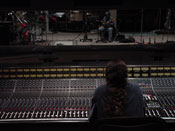 Mike Scheibinger: Of the three of us, I was the one with experience in library design. I was there to provide a higher comfort level for Steve and Greg so that they could proceed with confidence. I'm also a huge fan of their work from way back, both Steve and Greg, and that always helps more ideas come forward. There are a few library-specific technical points I help out with, too — just little things that help maximize the amount of material available for easier editing at the end of the recording process. Mostly, I'm just thankful to be a part of it all. Hanging with that crowd is an amazing experience. Mike Scheibinger: Of the three of us, I was the one with experience in library design. I was there to provide a higher comfort level for Steve and Greg so that they could proceed with confidence. I'm also a huge fan of their work from way back, both Steve and Greg, and that always helps more ideas come forward. There are a few library-specific technical points I help out with, too — just little things that help maximize the amount of material available for easier editing at the end of the recording process. Mostly, I'm just thankful to be a part of it all. Hanging with that crowd is an amazing experience.
Steve, which producers have really accentuated your sound in the past?
Steve Ferrone: The first producer I worked with was Mike Vernon, who produced Freddy King, and he was just really enthusiastic about the way I was playing. That encouraged me to stay, you know? But I would say the single biggest influence on my recording career has been Arif Mardin. When we started, he was producing Average White Band, and then he noticed I read music a little, and he said, "I've got a session, do you want to work on it with me?" As far as being really adventurous in the studio and trying stuff, it was him. He was the one who put the drums down first. I had no idea what the song was, and he noticed that because I wasn't playing with anybody and I didn't have anybody to climb up above to hear myself, I was just cruising. He said, "You've got to hit the drums a lot harder than that…play like you're playing with the band." So I had to muster that enthusiasm and hear something in my head.
Was it difficult tough to replace Robbie Mcintosh in Average White Band after his death?
Steve Ferrone: It wasn't hard at all. I was Robbie's favorite drummer. Robby was an old friend and liked the way I played, and I liked the way Robbie played. We'd hung out some just as AWB was starting to get some airplay with Pickin' Up the Pieces. So when Robbie died, we'd been hanging out whenever he was in Los Angeles. I was invited to that party but I didn't go, I had to work. So I went around to see the guys [in the band] and everyone was sitting around dejected. I just said, "Look, you've come this far, Robbie wouldn't want you to stop. You guys have to keep going." It was just a mess, so we all just got really shitfaced. Then they called me up and asked if I could come down for a gig. I'd go out and do weekends with them, and then the weekends I had to work with Bloodstone, Stix Hooper from the Crusaders would go play with them. We'd sit down and start to jam — Stix would play some and I'd play some — and they'd perk up. Finally one day we did a gig down at the old Long Beach Arena, and Ahmed Ertegun came up to me and said, "You're joining the band." I said, "Ahmed, I'd love to do that because I love playing with the band, but I'm under contract with Bloodstone." And he said, "You're out of that contract, I'm getting you out. You're in the band." And the next thing you know, I was in AWB.
Like Steve with AWB, your work with Jackson Browne was really a turning point in your career. What do you think it was about how you mixed The Pretender that led to your long partnership with Jackson?
Greg Ladanyi: Jackson was making a change, and I said I would like a shot at mixing this record. I think he did some mixes with some other people, I don't know exactly what happened, but he came back to me and said, "You got the job." By the time that job was done, I believe I got Jackson's respect and trust, and he got mine. We worked hard together.
How old were you at the time?
Greg Ladanyi: It was '74, so I was 24 and Jackson was about 27. After The Pretender we made Running On Empty, another record that I engineered and Jackson produced. But I think I really filled a void. I was responsible for making sure I got everything that he was doing on the road on tape. "Maybe we can try it this way. Maybe we can do this." So when we did Hold Out, he asked me to be the co-producer. He allowed me to become part of the record, and that allowed for more of that responsibility. That created the relationships with Don Henley, Danny Korchmar, Fleetwood Mac and Toto. I just became more and more involved in how a record was made. I knew what to listen to and to listen for. I learned what to communicate and how to inspire.
What are some of those ways you learned to inspire? That seems like such a nebulous thing to do.
Greg Ladanyi: I think with Jackson it was developing trust. "Hey Jackson, that performance was really great. I think you should come in and listen to it before we erase it." Because it wasn't like what we have now. We'd run out of tracks, so we had to be selective. That's another very big part of my foundation of learning. You had to learn how to communicate and express when somebody did something really well. "I don't think you quite got it. Maybe you should do it again." He had to trust me. That is, again, a work in progress that develops a skill set.
Have you ever had the trust not be there for a project?
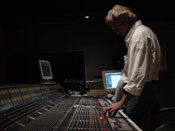 Greg Ladanyi: It's happened, but in more of a positive way than a negative way. An artist will think, "OK, I've done my best." We might be pushing him or suggesting he go that extra mile, but maybe that artist feels, "No, this is what it is. This is what I'm trying to do. You don't get it." And at that point, you have to back off and say, "OK, I understand." Anybody I've worked with that's great has crossed that road with the producers, but it's never stopped the process. It's just stopped the process of asking them to do that particular thing again. Greg Ladanyi: It's happened, but in more of a positive way than a negative way. An artist will think, "OK, I've done my best." We might be pushing him or suggesting he go that extra mile, but maybe that artist feels, "No, this is what it is. This is what I'm trying to do. You don't get it." And at that point, you have to back off and say, "OK, I understand." Anybody I've worked with that's great has crossed that road with the producers, but it's never stopped the process. It's just stopped the process of asking them to do that particular thing again.
Steve, you've said that you're not as much a beat guy as you are a song guy. What do you mean by that?
Steve Ferrone: I enjoy playing songs more than soloing or something that just stays there in one groove. There's always the exception. The Big Payback is probably my favorite groove. The number of times that song has been sampled just goes to show how good it is. It's nice if you can find a really good groove to go through a song.
Has anybody ever sampled your grooves?
Steve Ferrone: AMG came out with this song called Bitch Betta Have My Money and I loved that. Then somebody said there was an album out, so I bought the album. Then all of a sudden, [Average White Band] School Boy Crush. They used my song! I was so flattered. I've got a publisher who takes care of all that. If they hear songs or somebody tells them something or I hear something, they'll check it out and make sure that the sampler got permission and paid for it. I started to get awards from ASCAP for writing songs that I didn't know about! I'm flattered if people use it, and I'm even more flattered when I get a check for it. I do take issue with people like Puff Daddy, people who haven't really written anything and just exploit. I'm not really overly keen on that. But AMG was funny, man. His stuff was funny, and that's what it was all about.
Greg, take me back to 1973 and your experience working with Captain Beefheart on Bluejeans and Moonbeams.
Greg Ladanyi: It was the most bizarre, twisted experience for me. This was before I was an engineer and before I went to the Sound Factory. I was the business side of Stronghold Studios, and my partner, Al Thomas, owned the studio. I found the job, brought them in, and they paid us $5,000 for studio time. We spent the money in two days paying our bills. But there was a clash with Al and the producer, and they wanted their money back. There was no way, but we didn't say that. I just said [to producer Andy DiMartino], "I'll do this." I had this personality that was effective that way. So I was on the phone with Al every 20 minutes. "How do I patch this thing in?" I knew what things were and I had live mixing experience, but never in a studio. And it was weird because Beefheart was out of his mind. He was trippin', the band was trippin', and I was only 21 years old. We were there all night and they were doing this stuff that all sounded like spaghetti to me. But I loved the feeling of being in the studio. Oh, that was amazing. So I had a pretty big crash course in personalities, the studio, delivering, and that was when I got the job at the Sound Factory as a second engineer.
Steve, how did working with Tom Petty and the Heartbreakers change you as a drummer and songwriter?
Steve Ferrone: Everybody in that band is extremely prolific. So I was sitting there with all those guys that were writing stuff constantly and I thought, "Well, I really should do that. I've got all these songs in my head that I've never finished." So I had a go at it. I went through an agonizing breakup with a fiancé and I was living over in Woodland Hills, California, sharing a house with Marcel East, Nathan East's brother, and there was a studio in the house. This was late nineties, and I'd been sitting around moping, listening to Ennio Morricone, and I thought of an idea for a song that I'd give that treatment to. So I went downstairs and said, "I've got an idea for a song." We'd been sharing the house for a year and I'd never gone into the studio. So I went down and out popped this song, Woody Creek. And then another song came after that, and another song came after that, and another song…
How was it working with Johnny Cash?
Steve Ferrone: Johnny was a gentleman. He sent me one of his old albums from Sun Records and he signed it and said thanks for playing on my record. He was a real gentleman, but then he would sing these songs about going out to shoot a man just to watch him die. I told him he was a gangsta rapper!
Quincy Jones is another great you've worked with.
Steve Ferrone: There's another guy who taught me a lot of stuff. Quincy taught me the ins-and-outs of playing big band. That's a tough seat, boy. It comes at you fast and furious. The man is a legend. He's done everything. I read a book called Jazz Anecdotes and I was talking to Quincy about this one particular incident that happened where a band leader paid his bass player five bucks — because things were going so badly — to jump off the barge when they played the chorus. They were playing on a barge on the Potomac River. So the bass player did it! He hands his bass to the trumpet player, jumps overboard, and comes back soaking wet. So they've finally got the audience going wild and the band leader says, "I'll give you another five bucks if you do it again." So he jumped over the barge again into the river. So I'm telling Quincy this story, and he said, "You know who he gave his bass to? Me." 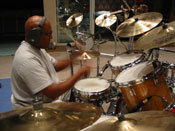 Quincy was in that band! Quincy also got to do the inaugural for Clinton. So he calls me to go down there and do it — me and [keyboardist] Greg Phillinganes. The next day we get to the gig and two things happen. Ray Charles shows up, and he's going to do the song. Now we rehearsed the song, but Ray hasn't been there, Greg has. Ray comes through and there's a piano down there in the pit. Now I've worked with Ray before, and Ray used to love to yell at drummers, but I figured the way to not get yelled at. When he used to play, he used to drop his left shoulder. If you fell with your bass drum and stayed with him when he dropped that left shoulder, he wouldn't yell at you. But if you thought that you had the tempo and you dropped it, he'd yell at you. "What are you doing!? Where are you going?!" So Ray isn't going to yell at me because he's going to be on the top riser. But he didn't go up top. He comes down and sits down at the piano in the pit with us. I think, "Well, this is even better because I can see him. He's going to be right here." They hit a hydraulic thing and it lifts the piano up. All I can see is Ray Charles' legs. And when he plays, his legs go all over the place…got nothing to do with anything. So I go running over and say, "Ray, Ray…it's Steve. Steve Ferrone." "Oh, hey man. How you doin'?" "Well, I was doing fine, but now I can't see you." He said, "I can't see you either!" So it's useless talking to him. I run over to Quincy. "Quincy, I can't see him. He's going to yell at me in front of the whole country!" Quincy is like, "I've got it. I'll stand up there on the stage and when his shoulder drops, I'll give it to you." But what Quincy didn't know is you have to stay with him for a verse, a chorus, and all the way through until he's comfortable. When he's comfortable, you can let him go, but you have to stay with him for the longest time. So we're sitting there doing the live show, Quincy tries to give me the shoulder and he dropped early. Then I hear Ray, "What are you doing down there, drummer?!" Quincy was in that band! Quincy also got to do the inaugural for Clinton. So he calls me to go down there and do it — me and [keyboardist] Greg Phillinganes. The next day we get to the gig and two things happen. Ray Charles shows up, and he's going to do the song. Now we rehearsed the song, but Ray hasn't been there, Greg has. Ray comes through and there's a piano down there in the pit. Now I've worked with Ray before, and Ray used to love to yell at drummers, but I figured the way to not get yelled at. When he used to play, he used to drop his left shoulder. If you fell with your bass drum and stayed with him when he dropped that left shoulder, he wouldn't yell at you. But if you thought that you had the tempo and you dropped it, he'd yell at you. "What are you doing!? Where are you going?!" So Ray isn't going to yell at me because he's going to be on the top riser. But he didn't go up top. He comes down and sits down at the piano in the pit with us. I think, "Well, this is even better because I can see him. He's going to be right here." They hit a hydraulic thing and it lifts the piano up. All I can see is Ray Charles' legs. And when he plays, his legs go all over the place…got nothing to do with anything. So I go running over and say, "Ray, Ray…it's Steve. Steve Ferrone." "Oh, hey man. How you doin'?" "Well, I was doing fine, but now I can't see you." He said, "I can't see you either!" So it's useless talking to him. I run over to Quincy. "Quincy, I can't see him. He's going to yell at me in front of the whole country!" Quincy is like, "I've got it. I'll stand up there on the stage and when his shoulder drops, I'll give it to you." But what Quincy didn't know is you have to stay with him for a verse, a chorus, and all the way through until he's comfortable. When he's comfortable, you can let him go, but you have to stay with him for the longest time. So we're sitting there doing the live show, Quincy tries to give me the shoulder and he dropped early. Then I hear Ray, "What are you doing down there, drummer?!"
In closing, Mike, what separates this collection from what you already have in the Sony catalog?
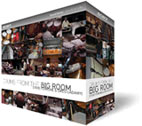 Mike Scheibinger: This collection is presented in an unmixed, multitrack format. Also, it's Steve Ferrone, which is remarkable in that I can't think of any other drummer who has played on so many big hits. Plus, we had a legendary record producer at the desk. There are many fine drum sample libraries out there, but none that merge a star drummer, a legendary producer, and a historic performance space. The combined legacy of these three things alone is staggering. In addition, we have the advantage of Leo Cavallo's editing expertise. Leo is a master of library design, and his attention to detail is unsurpassed. Leo put it all together to make this collection easy and fun to use. Mike Scheibinger: This collection is presented in an unmixed, multitrack format. Also, it's Steve Ferrone, which is remarkable in that I can't think of any other drummer who has played on so many big hits. Plus, we had a legendary record producer at the desk. There are many fine drum sample libraries out there, but none that merge a star drummer, a legendary producer, and a historic performance space. The combined legacy of these three things alone is staggering. In addition, we have the advantage of Leo Cavallo's editing expertise. Leo is a master of library design, and his attention to detail is unsurpassed. Leo put it all together to make this collection easy and fun to use.
How do you plan to grow this collection? Will the Ferrone sessions stand alone, or will you pursue different drummers? Will Ladanyi continue to produce the sessions?
Mike Scheibinger: This is our first library of multitracked drums produced in-house, and Ferrone stands alone no matter where he stands! Of course we'd like to have others. There will never be a single library that serves as the be-all-end-all — every one of our libraries has a little something special going on. We have a great relationship with Greg, and we'll be working together again, but nothing is set in stone right now in terms of talent.
|
 |
|